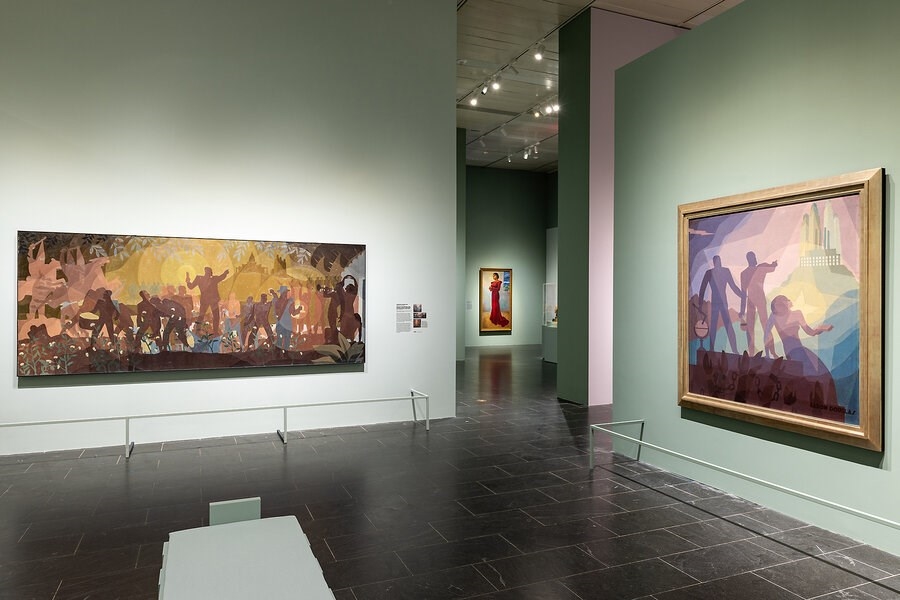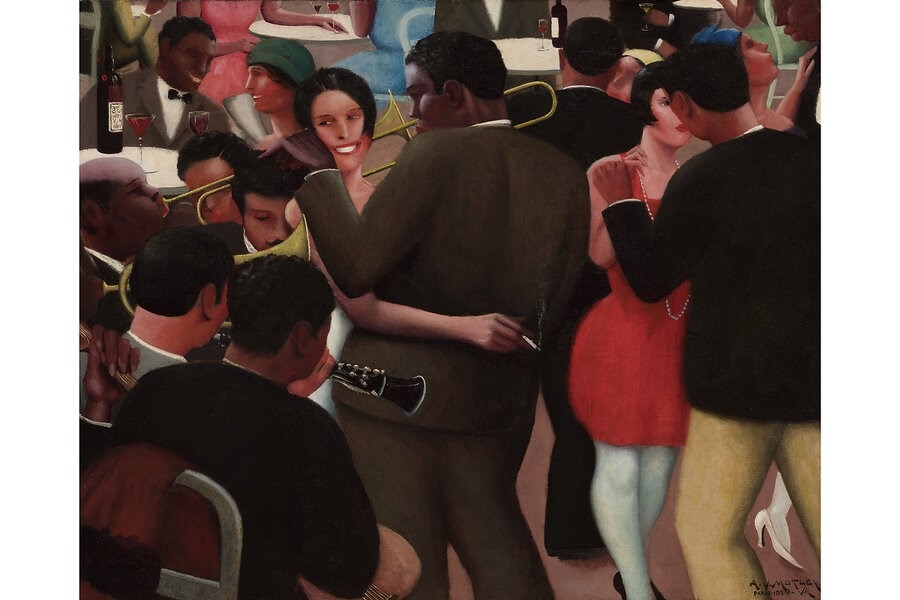REPRINTED WITH PERMISSION FROM THE CHRISTIAN SCIENCE MONITOR
An exhibit at the Metropolitan Museum of Art includes more than 160 works of art – and exudes dignity in its timeless celebration of Black life.
 The exhibition “The Harlem Renaissance and Transatlantic Modernism” is at The Metropolitan Museum of Art in New York City through July 28, 2024. Anna-Marie Kellen/Courtesy of The Met
The exhibition “The Harlem Renaissance and Transatlantic Modernism” is at The Metropolitan Museum of Art in New York City through July 28, 2024. Anna-Marie Kellen/Courtesy of The Met
| NEW YORK - In a crowded corridor of the Metropolitan Museum of Art at Fifth Avenue in New York, Denise Murrell suits up for an explorative journey, like an astronaut preparing to step on a foreign surface. As she puts on modest audio equipment, she bristles mildly when she is recognized as the lead curator for the “Harlem Renaissance and Transatlantic Modernism” exhibit.
It is a playful shake and smirk, to be sure.
Over the next 30 minutes or so, she will take us on a trip that definitely shows that the famed art and social movement of the 1920s isn’t just in Harlem – or Chicago, or Louisville, Kentucky, for that matter.
The Renaissance is everywhere.
Like the Renaissance in Harlem, the Met’s exhibit might have begun with a single seed – a March 1925 edition of the magazine Survey Graphic. The cover reads: “Harlem, Mecca of the New Negro”
The publication was edited by Alain Locke, the father of the Harlem Renaissance, and featured W.E.B. DuBois and Countee Cullen. A significant portion of that issue went into Locke’s book, “The New Negro,” and would have been a compelling starting point for any tour.
Dr. Murrell goes in a direction that not only celebrates Harlem, but the various expeditions of Black folk who left the South during the Great Migration. Her focus? “One Way Ticket,” a publication from the iconic Langston Hughes.
“He is basically saying, you know, I pick up my life and take it away on a one-way ticket, gone up north, gone out west, gone,” Dr. Murrell says. “This idea of a one-way ticket … shapes the exhibit.”
 Image © The Metropolitan Museum of Art, photo by Juan TrujilloOne of the featured works in the Met exhibit is "Blues," 1929, by Archibald J. Motley Jr. (American, 1891–1981) © Estate of Archibald John Motley Jr. All reserved rights 2023 Bridgeman Images
Image © The Metropolitan Museum of Art, photo by Juan TrujilloOne of the featured works in the Met exhibit is "Blues," 1929, by Archibald J. Motley Jr. (American, 1891–1981) © Estate of Archibald John Motley Jr. All reserved rights 2023 Bridgeman Images
“Harlem Renaissance and Transatlantic Modernism,” on display through July, isn’t just replete with the art of the period – paintings, literature, and sculpture. The exhibit of more than 160 works of art exudes dignity in its timeless celebration of Black life. It is also, as reviewers have noted, a corrective to the Met’s botched 1987 exhibit – its only previous showcase of the Harlem Renaissance.
“The museum isn’t framing the show as an institutional correction, though how can it be viewed otherwise? At the same time, it’s more than just that. It’s the start — or could be — in moving a still-neglected art history out of the wings and onto the main stage,” wrote critic Holland Cotter, who saw both exhibits, in his review for The New York Times. “What Locke wanted for a new Black art was the same visibility that white art has always had in the public consciousness, in the market, in the history books. But he also insisted that, in this new art, a Black identity be foregrounded, maintained and nurtured, to create a fresh and distinctive cosmopolitanism. That’s a dynamic evident in the Met show.”
One of the featured artists, Archibald Motley Jr., wasn’t even from Harlem. Motley was a native of New Orleans who made his way to Chicago and made a name for himself through his artistry. According to Dr. Murrell, his art was essential to how the exhibit was portrayed.
“For each of the 12 galleries in the show, we think about what we call the vista view, which draws people into the galleries and sets the theme for the rest of what is happening,” she says. “You’ll see eight or 10 paintings by Motley that are set in Southside Chicago, so there’s this idea of the Renaissance as a national phenomenon.”
“Artists associated with the New Negro movement shared a commitment to portraying all aspects of everyday African American life in accordance with cultural values established by the Black community itself,” the exhibit reads. “This radical vision … centered ordinary people with a blend of admiration and critique that rejected stereotype and oversimplification, defying conventional beliefs.”
The vision to share the message of Black renaissances is one shared by groups and individuals such as Janine Tiago De Melo, a psychology specialist. She has worked extensively with the Parents of Students of Color (POSOC) group at the Cathedral School of St. John the Divine in New York City.
“This isn’t your grandparents’ sort of equity discussion on DEI, or a book club for that matter. We know that people learn through many modalities,” Dr. De Melo says. “We didn’t just want to read ‘Caste’, we also wanted to listen to the podcast with Isabel Wilkerson – any modality that would work where you can engage in the conversation.”
The group, a hybrid of a parents’ association and various POSOC groups, evolved after the 2020 murder of George Floyd. It is a reminder that renaissances aren’t just found with the artifacts of a museum, but in the Black experience, and can spill out into the streets like overturned paint.
 © James Van Der Zee Archive, The Metropolitan Museum of ArtAmong the items on display in the Met's exhibit is "Couple, Harlem" by James Van Der Zee, (American, 1886– 1983). James Van Der Zee Archive, The Metropolitan Museum of Art; Gift of Donna Van Der Zee, 2021.
© James Van Der Zee Archive, The Metropolitan Museum of ArtAmong the items on display in the Met's exhibit is "Couple, Harlem" by James Van Der Zee, (American, 1886– 1983). James Van Der Zee Archive, The Metropolitan Museum of Art; Gift of Donna Van Der Zee, 2021.
The exhibit’s introduction, full of paintings and faces and history, are breathtaking enough, but there is higher ground. The Met’s presentation and Dr. Murrell’s creativity take the lexicon of Black ideology and theology, and bring it to life.
“Lift Every Voice And Sing,” to most folks, is known as the Black National Anthem. In this exhibit, sculptor Augusta Savage’s interpretation of that anthem is truly divine – a beautiful bronze harp with African faces. The origin story behind an earlier, large-scale plaster version of “The Harp,” like the Black experience, has its elements of heaven and hell.
“Augusta Savage made a monumental sculpture. ... Sixteen feet tall, at the 1939 World’s Fair on Long Island,” Dr. Murrell explains. “But like many artists of the period, she didn’t have the means to have the sculpture cast in bronze during the fair or before the fair.
“And then after the fair ended, she didn’t have the means to have it shipped, removed, and placed in storage somewhere until she could later have it cast,” she continues. “And so the sculpture, the 16-foot sculpture, was destroyed as the World’s Fair was broken down.”
The exhibit’s name suggests duality in and of itself. “Harlem Renaissance” speaks to perceptions of the new Negro in the 1920s. Transatlantic modernism speaks to a desire for freedom that couldn’t be held in the continental states – because anti-Black supremacy was also worldwide. Those chronicles are depicted and celebrated with publications such as The Crisis, the NAACP’s magazine, which was founded by DuBois. Speaking of the famed activist, his idea of “double consciousness” was conveyed profoundly in “Shades of Black,” another Motley staple.
In New York, Baltimore native Joseph Smith beams with a great sense of cultural pride as he peruses the exhibit. He wants people to know there are “different dimensions” of Black art that go beyond popular music.
“This is a great tribute to our African American ancestry, and it shows that art is a great part of our lives,” Mr. Smith says. “ It shows that we are more than just what you see on television. You know, the stereotypical pimp or hustler. I think we need to show more of this kind of work.”
Page created on 6/3/2024 3:27:39 PM
Last edited 6/3/2024 3:41:32 PM
